2026 Author: Priscilla Miln | [email protected]. Last modified: 2025-01-22 17:55:21
Red-eared turtles are also called yellow-bellied. These are the ones that are so common among pet lovers. It should be noted that, unfortunately, such popularity has a downside. The red-eared domestic turtle in most cases is doomed to death or life in unsuitable conditions for it. In order to avoid this, the owner of a pet turtle should know as much as possible about these amazing animals. In this article, we talk about red-eared turtles, their maintenance and feeding.
Red-eared turtles at home
This species of pet turtle is very hardy and is great for those who are just starting to care for animals. However, in order for your pet to be he althy and happy, it must be properly cared for. Red-eared turtles need a shore (land) that is warm, and water that is warm and clean, in addition, the liquid must be changed regularly.
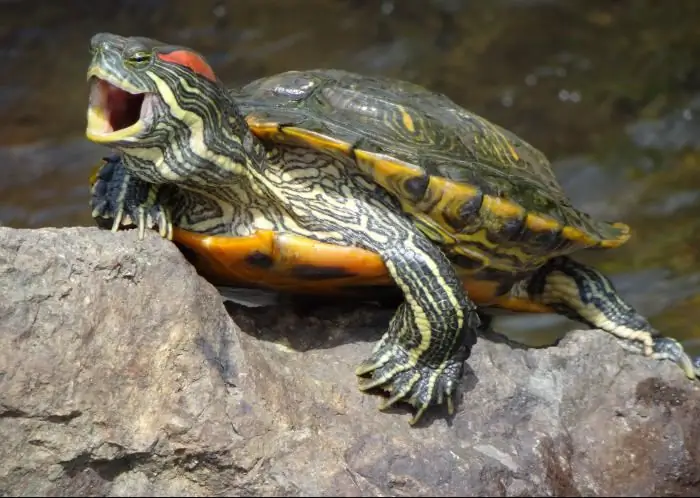
Character
Red-eared turtles are strong, fast, and can be aggressive. They easily attack both other types of turtles and each other. In addition, they have charisma and personality, and this is what distinguishes them from other species. Red-eared turtles are very skilled when it comes to stealing food from other animals. In the wild, they are an invasive species and destroy and displace endemics.
Red-eared turtle and baby
Turtles of this species can make wonderful pets, for example, because allergies to reptiles are extremely rare. Caring for a red-eared turtle at home is not difficult for an adult. However, if you decide to get it as a gift for a child, then it is worth remembering that all responsibility for the life and he alth of the animal lies solely with you. Children are not able to provide proper care for domestic red-eared turtles, in addition, they can quickly lose interest in a new toy and forget about it. But it needs to be fed, heated, washed and changed the water in the aquarium.
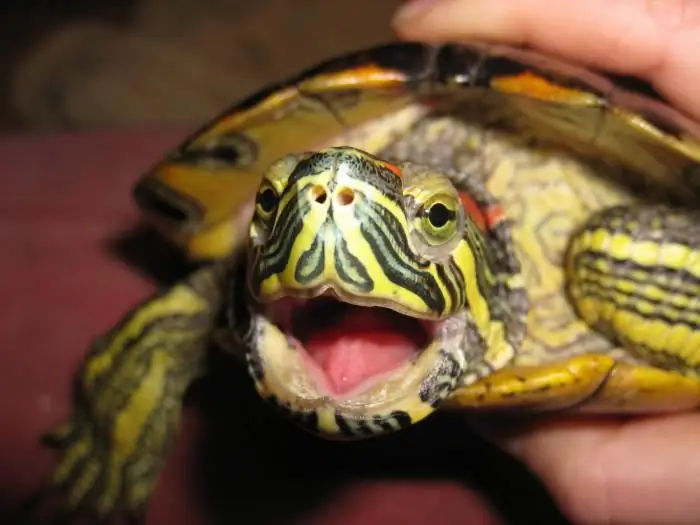
Appearance
Red-eared turtles, which require some effort to care for, are easily recognizable. They cannot be confused with any other species. Characteristic of this species is a red or sometimes orange stripe that starts from the eye and continues along the neck. The upper part of the shell is rounded and smooth. Color - olive green with yellow and black lines. The lower part of the shell is yellow, but withit darkens with age. The spots on the shell also darken, and the red stripe on the head loses its brightness.
Sizes
The dimensions of this reptile are measured with a ruler from edge to edge, the unevenness of the shell is not taken into account. Newly hatched small red-eared turtles are about 2.5 cm long, and after a year of life they grow to 5-7 cm. The average size of a reptile is from 25 to 30 cm, depending on the conditions of detention.
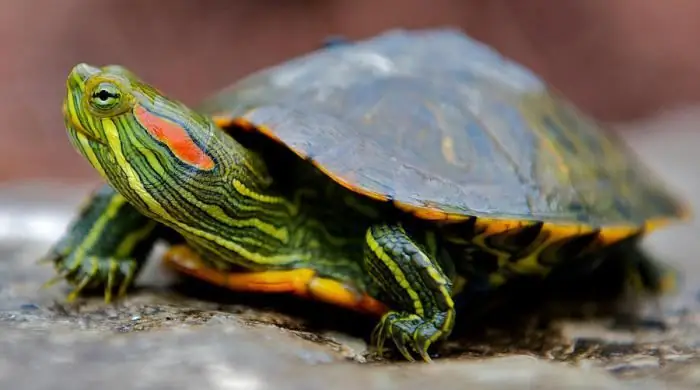
Age
Size cannot be a sign of a turtle's age. At home, these reptiles grow faster than in nature. This is the result of an abundance of food and ideal conditions. However, if you take care of the red-eared turtle at home correctly, then it will please you much longer. A wild reptile will not live longer than 20 years, while a domestic one can reach 40 years.
Appeal
You need to remember that when you take a reptile in your arms, you need to be careful. It can be slippery, hiss, resist, and have a bowel movement. The red-eared tortoise has sharp claws, powerful paws, it bites painfully. You need to hold the reptile with two hands. Mishandling has hurt many owners and many more turtles.
After you have held the turtle in your hands, wash them with soap and water. This is especially true for children. The reptile lives in different conditions and with different bacteria. Keeping food fresh and the aquarium clean is especially important, as turtles can carry salmonellosis.
The turtle is notshould have access to the kitchen and areas where food may be found. Also, do not wash your reptile, aquarium, and accessories in the kitchen sink.
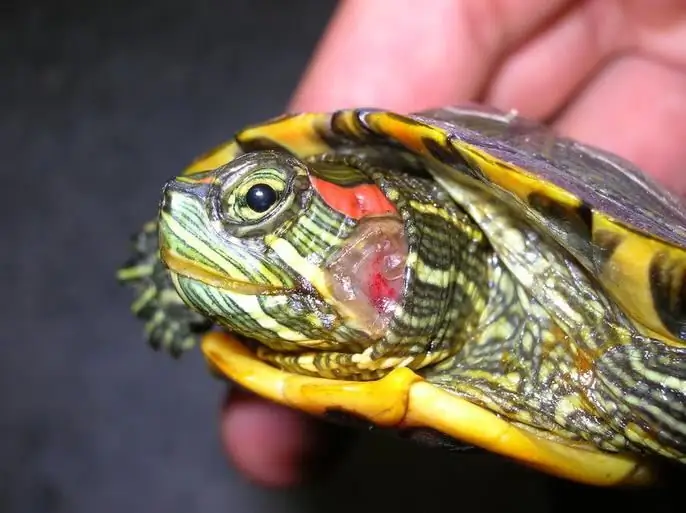
Handling babies
In most cases, turtles that appear in a home aquarium are babies. They are very tender and it is important to keep them comfortable and eating well. Baby turtles have a high mortality rate, can die without external cause, and are susceptible to disease.
If you notice something on the underside of a turtle's shell, it's most likely the stomach sac. A reptile that has just hatched consumes all the necessary nutrients from it. Therefore, it should not be touched or removed. During the first time, turtles may refuse to eat until the stomach sac is resolved.
It is better not to pick up small turtles, as they can be frightened, sick and stressed. No need to stand near the aquarium, knock on the glass. Give them some time to get used to and start eating. It is important that the temperature of land and water is stable.
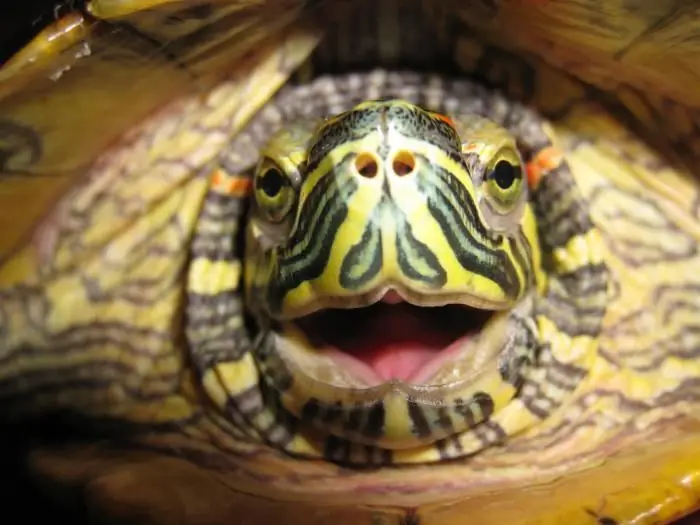
Never place the aquarium in a draft or direct sunlight. Do not keep adult and small turtles together. Small reptiles must have access to land. The water temperature for keeping babies is 26-27 degrees, and the land temperature is up to 32. The water should be clean, and if there is no filter, then it should be changed every couple of days. You can feed the turtles branded food. Remember that most problems can be avoided by simply creating the right conditions.
Red-eared turtles: care and maintenance
To keep the red-eared turtle you will need an aquarium or a terrarium. Its volume is 150-200 liters. Remember that your little turtle will get bigger over time. She needs such a height of water so that she can freely roll over, that is, not less than the width of her shell. However, this is the minimum water level that the red-eared turtle needs. The more room she has to swim, the better.
In addition, she needs artificial land, on which the red-eared turtle will crawl out to bask. The island can be purchased at the pet store. Basically, that's all that's needed. The island should be stable, have a sloping rise, it should not have burrs and sharp corners.
Land must occupy at least 25% of the surface of the terrarium and meet the following requirements:
- The island must be heated. The temperature on it should be at least 10 degrees higher than the water. Remember that too much temperature will cause the reptile to overheat.
- Land must be semi-flooded (at least one of its sides is in water).
- The island must be safe. The turtle must not get stuck between it and the aquarium glass.
- When heated, it should not release toxic substances.
- Reliability and stability are important, as turtles of this species are very strong and can turn it over.
- Land must have texturesurface.
Feeding
Turtles are omnivorous, they feed on various types of food. Variety is important to them. You can feed the red-eared turtle with artificial food, vegetables, food for aquarium fish, insects, aquarium plants, fish and invertebrates. In addition to variety, it is important to ensure that the reptile's diet is balanced and high in calcium. They, like other pets, have a tendency to overeat.
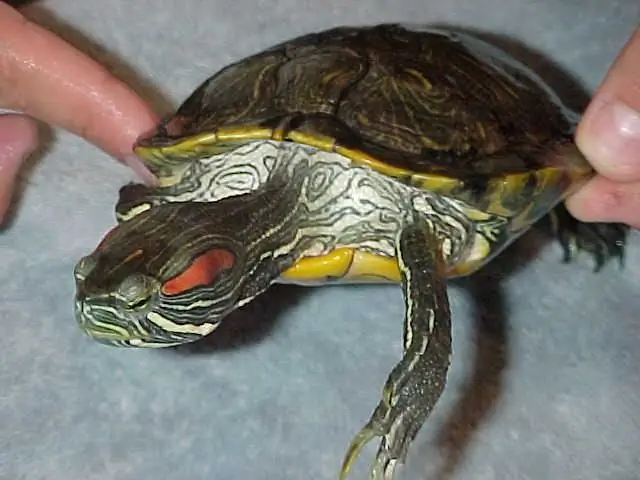
Hibernation
Hibernation is the period in which the turtle falls during the winter. It is not necessary for the red-eared slider to hibernate. Also, this is highly discouraged! Therefore, do not stimulate hibernation! Why might this process be unsafe?
For example, because you may not have enough experience to care for a reptile during this period. You will not have the conditions for the turtle to hibernate normally. The reptile may not need it at all. Sick or young turtles may be too weak to survive this period.
Those reptiles that hibernate in natural conditions burrow into the vegetation and silt at the bottom of the reservoir, which has a large area and shallow depth. Turtles do not rise to the surface during this period: they absorb oxygen through the membranes that are located in their mouth, cloaca and pharynx. In this case, the depth of the reservoir, its temperature and the oxygen content in it are extremely important. The vast majority of artificial ponds do not providenecessary conditions.
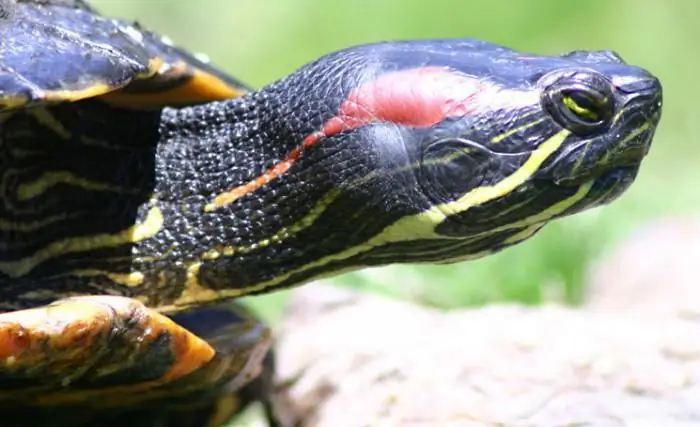
Thus, captive-raised red-eared sliders should not be put into hibernation. What is the key condition for this? The water temperature in the terrarium should not be less than 24-26 degrees. Otherwise, the low temperatures will remind the red-eared slider of the winter months to spend hibernating.
Recommended:
What should be an aquarium for turtles

Now many consider it their duty to have some kind of animal, and the turtle is very suitable for this. Especially when you consider that she can live with her owner for up to 30 years. A turtle aquarium can also become a bright interior detail
Do-it-yourself UV lamp for a turtle. The effect of ultraviolet light on turtles

Turtle is a cold-blooded (ectothermic) animal. All processes in her body are entirely dependent on changes in ambient temperature. In nature, she loves to bask in the sun. In the terrarium, its energy is replaced by an ultraviolet lamp. The right source of light is vital for a turtle. But how among the abundance of light bulbs to choose the option that will not harm your reptile? And is it possible to create it with your own hands?
How turtles breed in captivity

Turtles are perhaps the most ancient reptiles currently living on our earth. From this article you will learn how turtles breed, and what are the conditions for their maintenance
Red cats. Genetics of red color in cats

Red cats look very impressive, and many breeders would like to sell more of these kittens. Of course, in order to get red offspring, first of all, you need to choose the right producers. What should be the hair of the parents so that they have red kittens?
Decorative turtles: care, types and features of the content

Unpretentious animals are very popular these days, because not every owner is ready to devote much time to their pets. Decorative turtles do not require particularly complex care, you only need to remember the basic rules and follow them

